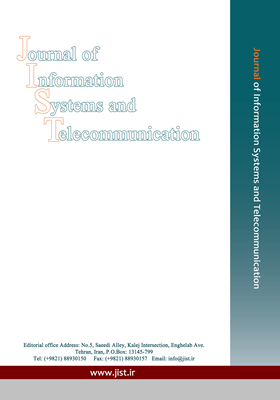Cost Benefit Analysis of Three Non-Identical Machine Model with Priority in Operation and Repair
الموضوعات : Machine learningNafeesa Bashir 1 , Raeesa Bashir 2 , JP Singh Joorel 3 , Tariq Rashid Jan Jan 4
1 - Department of Statistics, University of Kashmir
2 - Mathematics and Quantitative Analysis, Amity University, Dubai, UAE
3 - Department of Statistics, University of Jammu
4 - Department of Statistics, University of Kashmir
الکلمات المفتاحية: Reliability Measures, Mean Sojourn Time, Laplace Transformation, Laplace -Stieltjes transformation,
ملخص المقالة :
The paper proposes a new real life model and the main aim is to examine the cost benefit analysis of Textile Industry model subject to different failure and repair strategies. The reliability model comprises of three units i,e Spinning machine (S), Weaving machine (W), Colouring and Finishing machine(Cf). The working principal of the model starts with spinning machine (S) where in unit S is in operative state while as weaving machine, Colouring and Finishing machine are in ideal state. Complete failure of system is observed when all three units of system i.e. S,W and Cf are in down state. Repairperson is always available to carry out the repair activities in the system in which first priority in repair is given to Colouring and Finishing machine followed by Spinning and weaving machine. The proposed model attempts to maximize the reliability of a real life system. Reliability measures such as Mean Sojourn time, Mean time to system failure, Profit analysis of system are examined to define the performance of the reliability characteristics. For concluding the study of such model, different stochastic measures are analyzed in steady state using regenerative point technique. The tables are prepared for arbitrary values of the parameters to show the performance of some important reliability measures and to check the efficiency of the model under such situations.
[1] A. Kumar and S. C. Malik, “Reliability Analysis of a Redundant System with ‘FCFS’ Repair Policy Subject to Weather Conditions”, International Journal of Advanced Science and Technology ,Vol. 29, No. 03, 2020, pp. 7568 – 7578.
[2] A. Kumar, D. Pawar, and S. C. Malik, ”Profit analysis of a warm standby non-identical unit system with single server performing in normal/abnormal environment,” Life Cycle Reliab Saf Eng., doi 10.1007/s41872-019-00083-2. 2019.
[3] Chib, Rakesh, J.P. S. Joorel, and V. Sharma “Profit Analysis of a Two Unit Priority System with Two Types of Repair Facility”, International Journal of Statistics and Reliability Engineering, Vol. 1, No. 1, 2014, pp. 69-81.
[4] I. kumar, A. Kumar, and M. Saina, ”Analysis of performance measures of computer systems with priority and maximum operation time,” Advances in intelligent systems and computing,Springer Singapore, vol 933, 2019.
[5] J.K. Sureria and S.C. Malik “Reliability Measures of a Computer System with Arrival Time of the Server and Priority to H/w Repair over S/w Up-gradation”, International Journal of Computer Applications, Vol. 65, No.13, 2013, pp. 44-48.
[6] M.S. Kadyan, S.C.Malik and J.Kumar, “Cost-Analysis of a System under Priority to Repair and Degradation” International Journal of Statistics and Systems, Vol. 5, No. 1, 2010, pp. 1-10.
[7] N. Bashir, R. Bashir and T R Jan, “Effectiveness Analysis of Two Non-Identical Unit System Model with Priority Unit Subject to Degradation and Inspection Facility”, IEEE International Conference on Computational Intelligence and Knowledge Economy (ICCIKE), 2019, pp. 40-45. ISBN 978-1-7281-3778-0.
[8] N. Gorjian Jolfaei , B. Jin , L. van der Linden , I. Gunawan and N. Gorjian , “Reliability modelling with redundancy—A case study of power generation engines in a wastewater treatment plant”, Qual Reliab Engng Int. 2019, pp. 1–13. https://doi.org/10.1002/qre.2573.
[9] R. Rathee and S. Chander “A Parallel System with Priority to Repair over Preventive Maintenance Subject to Maximum Operation and Repair Times”, International Journal of Statistics and Reliability Engineering, Vol. 1, No. 1, 2014, pp. 57-68.
[10] R. Sharma and J.P.S. Joorel, “Reliability modelling and cost benefit analysis of fruit juice manufacturing system”. Mathematics in Engineering, Science and Aerospace, Vol. 6, No. 2, 2015, pp. 281-293.
[11] S.Chander “Reliability models with priority for operation and repair with arrival time of server”, Pure and Applied Mathematika Sciences, Vol. XI, No. 1-2, 2005, pp. 9-22.
[12] S.C.Malik, M.S. Kadian, and J. Kumar , “Cost-Analysis of a System under Priority to Repair and Degradation”, International Journal of Statistics and Systems, Vol. 5,No.1, 2010, pp. 1 – 10.
[13] S.C. Malik, “Reliability Modeling of a computer System with Preventive Maintenance and Priority Subject to Maximum Operation and Repair Times”, International Journal of System Assurance Engineering and Management, Vol. 4(1), 2013, pp. 94-100.
[14] V.J. Munday and S.C. Malik, “Reliability Measures of a Computer System with Priority for Repair and Hardware Redundancy” , International Journal of Computer Applications, Vol. 125, No.8, 2015, pp. 32-37.
[15] Y.L.Zhang and G.J. Wang, “A Geometric Process Repair Model for a Repairable Cold Standby System with Priority in Use and Repair”, Journal of Reliability Engineering and System Safety, Vol. 94, 2009, pp. 90-100.
[16] M.S. Barak , Neeraj, and S.K. Barak “Proft analysis of a two-unit cold standby system model operating under different weather conditions”, Life Cycle Reliability and Safety Engineering, Springer, 2018, https://doi.org/10.1007/s4187 2-018-0048-6.
[17] O. Dahiya, A. Kumar, and M. Saini, “Modeling and analysis of concrete mixture plant subject to coverage factor and profust reliability approach”, Life Cycle Reliability and Safety Engineering, Springer, 9, 2020, pp. 273–281, https://doi.org/10.1007/s41872-019-00104-0.
[18] D. Goyal, A. Kumar, M. Saini, and H. Joshi. “Reliability, maintainability and sensitivity analysis of physical processing unit of sewage treatment plant”, SN Applied Sciences, Springer, 2020. https://doi.org/10.1007/s42452-019-1544-7.
[19] N. Gupta, M. Saini, and A. Kumar, “Operational availability analysis of generators in steam turbine power plants” SN Applied Sciences, Springer, 2020. https://doi.org/10.1007/s42452-020-2520-y.


